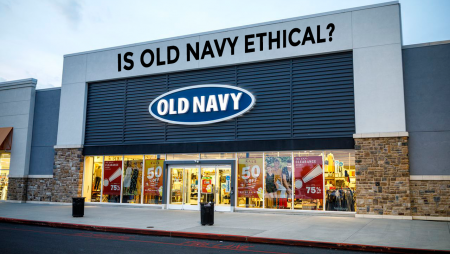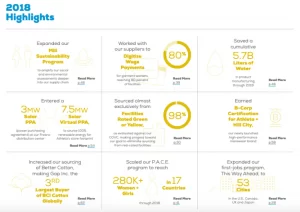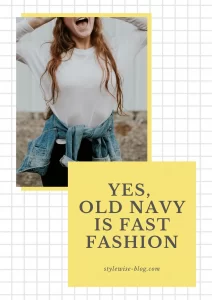

Is Old Navy ethical?
In the early days of StyleWise, I wore a lot of Old Navy.

I had just discovered corporate social responsibility reports and Old Navy (more specifically, its parent company, GAP Inc.) had a good one. In fact, it still looks good. You can view 2018’s report through this link (click the first link and a PDF will open).
The report is really a stunning, hope-inspiring document, telling of progress, using the word sustainability frequently, and emphasizing the important role of women throughout their supply chain and in their corporate office.
And I am, to be honest, impressed by the level of transparency they provide around where they’re not succeeding (namely in water reduction and efforts to provide fair employment to women in garment factories).
In 2013, that was enough for me. It looked legit, and it’s not as if they’re lying.
It’s just that they’re not telling the whole truth.

The Truth About Old Navy
I had a hard time researching for this post because GAP Inc. has been notoriously secretive about their factories. But, according to a recent article at Just Style, they finally released a list of their suppliers in September.
Countries of production include Bangladesh, Cambodia, China, El Salvador, Guatemala, Nicaragua, Philippines, Sri Lanka, and several more. More than half of the countries in which GAP Inc. does business have poor government oversight regarding garment factory wages and safety, and most if not all participate in sub-contracting practices in order to meet quick production turnaround, which limits the parent companies’ ability to monitor factory standards throughout their supply chain.
Old Navy brought in $8 billion in revenue last year (compare that to Everlane’s $200 million), an indicator of its scale. This makes it even more likely that subcontractors are being used in production, and reveals why GAP Inc. would find it necessary to contract with production facilities in nearly 30 countries around the world.
Basically, even if GAP Inc. is doing all they say they’re doing – and they probably are – they’re only skimming the top layer of their supply chain.
While they have incorporated several metrics for improvement into their CSR report – like using all “better” sourced cotton by 2020 – claims are often so vague that it’s unclear to the consumer what success would actually look like.
What They Tell Consumers
There’s also the fact that several sustainability metrics noted in the CSR document “resolve” issues in ways that essentially get them off the hook.
For instance, under “Consumer Use + End of Life” on page 11, they say that the primary way they’re dealing with circularity is by educating consumers about proper cleaning and care on social media. While this isn’t a bad thing by any means, it doesn’t actually work toward circularity at all.
Quality Issues
In my experience as a thrift shop manager, I saw lots of Old Navy come in over the years, and I can say with absolute confidence that fabric quality is abysmal.
It wasn’t always this way. When I shopped at Old Navy in middle school, the knit cotton was still thick in that early 2000s way and the denim was real denim that held up over the years.
When Old Navy rebranded about 5 years ago to compete with the “faster fashion” model of stores like Forever 21 and H&M – who generally appeal to a younger audience – textiles suffered.
The donors who gave us Old Navy items generally gave us a lot of it and, in many cases, donated on multiple occasions. The reason why? The stuff was trashed, totally unsaleable. Excluding some children’s items that hadn’t been worn, we had to send all of it for textiles recycling.
I’m not the only one with this experience. This Reddit thread almost unanimously reviews Old Navy as cheap and disposable.
The Good News
Still, the International Labour Organization (ILO) has applauded the fact that they’ve released a supplier list, because this will help watchdog agencies do their own assessments. While GAP Inc. themselves may not be fully aware of the scale of garment industry issues, access to their supply chain will mean industry experts can track their CSR claims more effectively in the near future.
The Verdict
Old Navy’s parent company, GAP Inc., has not provided sufficient evidence that they’re doing business in a counter-cultural way. Rather, their CSR report reinforces typical greenwashing language in the garment industry, providing many metrics that can’t really be measured in any meaningful sense.
Old Navy also happens to be the fastest fashion model in the whole GAP Inc. conglomerate, and their inattention to garment quality underscores that even if many sustainability and ethical standards were being met, the longevity of the garment and attention to circularity can matter the most when it comes to ecological claims.
Ethical Alternatives
There happen to be lots of ethical brands with similar aesthetics to Old Navy, many of them at lower price points.
Ethical Alternatives to Old Navy
If you’re trying to shop in bulk for kids, I always recommend searching Ebay or Poshmark for clothing bundles, or investing in a few Hanna Andersson pieces, which hold up much better and can be passed down.

I recognize that there aren’t always good alternatives when you’ve found a brand that fits you, but I guarantee you’ll find greater satisfaction in clothing made of better fabrics if not with better supply chain ethics.



